![]()
![]()
![]()
Use LEFT and RIGHT arrow keys to navigate between flashcards;
Use UP and DOWN arrow keys to flip the card;
H to show hint;
A reads text to speech;
45 Cards in this Set
- Front
- Back
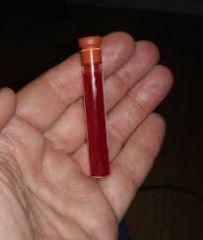
What are indications for colic surgery?
|
- Severe continuous pain showing no or only short duration of improvement with analgesia. - Pulse >60 bpm, progressively rising and weakening - Progressive CVS collapse- mm injected- cyanotic. - Increased abdominal distension. - Rectal findings positive with acute abdominal disease. - Progressive reduction in intestinal motility or continuous gastric reflux. -Serosanguinous peritoneal fluid with protein >2.5 g/l and WBC over 10x109/l |
|
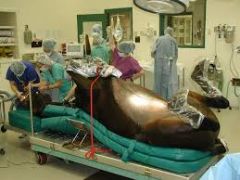
How is the horse positioned for colic surgery and what approach is used? |
Dorsal recumbency.
Generally a ventral midline laparotomy through the linea alba. |
|
|
Capacity of the equine stomach and can we exteriorise it? Indications for surgery of the stomach? |
15 litres and we cannot exteriorise it. Impactions in adults like ingesting unsuitable dry feed, a motility issue or secondary to liver disease. Pyloric stenosis in foals- acquired secondary to gastroduodenal ulcers or congenital. |
|
|
How can we treat a foal with pyloric stenosis? |
Pyloromyotomy- cut the muscle to release tension. Bypass pylorus gastrojejunostomy. |
|
|
Where is the duodenum located? How long is it and can we exteriorise it? |
Attached to the right dorsal body wall by a short mesoduodenum preventing exteriorisation. 1m long. |
|
|
How long is the jejunum and can it be exteriorised? |
Jejunum is 15-30 m long with a long 50cm mesojejunum. It can be exteriorised. |
|
|
How large is the ileum and what are features of it to tell it apart from other parts of the small intestines? Can we exteriorise it? |
70-80 cm ileum with a slightly thicker wall and distinctive antimesenteric bands, ileocaecal fold--> dorsal taenia of caecum. Cannot exteriorise the distal ileum and ileocaecal junction. |
|
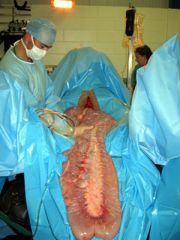
What is common complication after small intestinal surgery? How can we prevent this from happening? |
Ileus. Prevent this from happening by gentle tissue handling. |
|
|
What types of small intestinal lesion do not require surgical resection? Which ones need resection? |
Non strangulating lesions of the small intestine. Strangulation lesions require transection. |
|
|
Aetiology of a non strangulating small intestinal lesion leading to colic? |
Ascarids in young animals.
Tapeworm in the ileocaecal orifice. Unsuitable feed. Primary motility problem. Muscular hypertrophy. |
|
|
Treatment for a non strangulating small intestinal lesion causing a surgical colic? Prognosis?
|
Decompress at surgery and enterotomy only if necessary. Prognosis: very good. |
|
|
Signs of tumors leading to non strangulating SI colic? Name the most common SI tumor other symptoms that occur with it? Treat? Prognosis? |
Thickening of intestinal wall leads to partial/ complete obstruction of gut wall leading to altered motility. Lymphosarcoma accompanied by signs of weight loss. Treatment: Resection but often multifocal leaving this impossible. Prognosis: poor. |
|
|
Aetiology of anterior enteritis? Signs? Treament?Prognosis? |
Unknown: clostridia/salmonella/diet. Get mark distension of the proximal SI and stomach which resembles a surgical colic. Treatment: Medical- repeated nasogastric intubation. Surgery: decompression. Prognosis: 50-70% survival. |
|
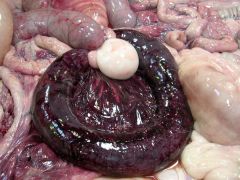
What is the general approach to a strangulating SI lesion?
|
1) Identify the cause of the strangulation such as pedunculated lipoma, intussusception, SI volvulus. 2) Reduce strangulation. 3) Assess gut viability. 4) Decompress, resect and anastomose if gut non viable. |
|
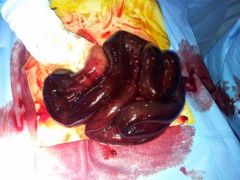
How do we assess the viability of a portion of gut?
|
Viable gut has active haemorrhage when nicked, peristalsis and pulses. Compromised: Avulsed vessels, haemorrhagic, red. Non viable: thin walled, black, grey or green colour. |
|
|
Prognosis for SI strangulating lesion depends on? |
Length of gut affected, duration of obstruction and consequence of CVS/endotoxaemic status of horse. 60-85% |
|
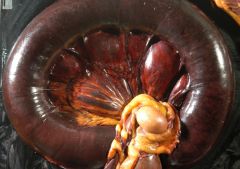
What is the most common cause of SI strangulation and what animals does it usually occur in? |

Pedunculated lipoma which mainly occurs in mature/obese animals. |
|
|
Treatment of a pedunculated lipoma SI strangulation? |
Resect the lipoma, pedicle and non viable gut.
|
|

Aetiology of SI volvulus?Signs? Prognosis? |
Jejunum rotates about its attachment in dorsal abdomen at cranial mesenteric arterial root. Signs SEVERE PAIN. Prognosis poor. |
|
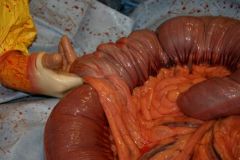
Aetiology of intussuception? Treatment? |

Young animals more common jejuno-jejunal area. Proximal intussusceptum into distal intusscuscipiens leading to obstruction. then strangulation as more gut entrapped and artery supply drawn in. Treat: Reduce. Assess viability +/- resection and anastomosis. |
|
|
What is the cause of thromboembolic colic? |
Migration of Strongylus vulgaris larvae. |
|
|
Types of SI entrapment leading to colic surgery? |
Epiploic foramen entrapment. Inguinal/scrotal hernia. Herniation through a mesenteric rent. Gastro-splenic ligament. Umbilical hernia. Diaphragmatic hernia. |
|

What part of the caecum is the only part we can exteriorise? What do we use the caecum to find?
|
The apex.
Dorsal band--> ileocaecal fold. Lateral band- ventral colon. |
|
|
Cause of primary caecal impaction? Secondary? |
Primary caecal impaction--> unsuitable food. Secondary--> Motility disorder. Hostipalized patient, repeated GA, sedation,painful condition, limited movement. |
|
|
How do we surgically resolve caecal impaction? |
Apical typholotomy +/- a caecal bypass.
|
|
|
Types of caecal intussuception? |
Caecocaecal. Caecocolic. |
|
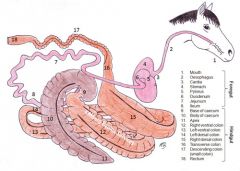
Describe the course of the large colon from the caecum to the anus?
|
Caecum--> RVC--> LVC --> LDC--> RDC--> Transverse colon--> small colon.
|
|
|
What parts of the large colon can we not exteriorise?
|
RVC, RDC and caecal base as attached to the body wall!!! |
|
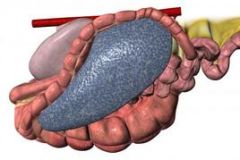
Causes of large colon displacements?
|
Gaseous distension.
Transient motility disorders. Sudden diet changes. Parturition. Idiopathic. |
|
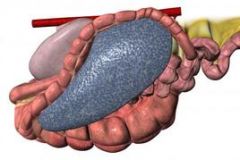
What happens with a left dorsal displacement of the large colon? Treat? |
Colon becomes entraped between dorsal aspect of spleen and nephrosplenic ligament adjacent to the left kidney. Treat with surgery and reduction of displacement. |
|
|
What can we do prior to colonic surgery ?
|
Relieve distension/impaction. This aids manipulation, allows repositioning in abdomen, improves post operative motility. |
|
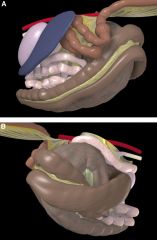
What occurs with a right dorsal displacement? |
The left colon migrates around the body of the caecum clockwise or anticlockwise.
|
|
|
Indications for surgery with a RDD? Treat? Prognosis? |
Unremitting pain, increasing distension, deterioration in CV status. Treat: reduce displacement, dump colon, replace. Can do a colopexy to abdominal wall if colon displacement recurs eg in breeding mares. Prognosis good. |
|
|
Complications of RDD? |
Progress to colonic volvulus/ torsion. |
|
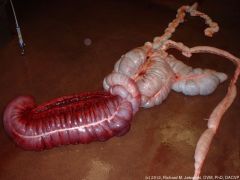
Signs of colonic volvulus/torsion? Treat?
|
180-360 torsion around caecolic junction. Extremely painful, rapid deterioration due to massive endotoxaemia. Treat QUICKLY. Colonic resection. |
|
|
Where do enteroliths tend to lodge? Treatment?
|
Narrow transverse colon. Treat surgically remove via enterotomy. |
|
|
Aetiology of atresia coli? Diagnose? Treat? |
Heritable congenital condition of foals results in atresia of segment of colon and or atresia ani.
Diagnose by contrast radiography. Treat: surgical correction if segment not to long. |
|
|
Causes of small colon impaction? Treatment?
|
Focal enteroliths.
Primary motility issue. Intramural haemorrhage. Manual decompression or enterotomy. |
|
|
How do we grade rectal prolapses? Which carry worst prognosis? Treatment? |
1-4 3-4 guarded prognosis as mesorectum tears. Treat: mild: clean, resect affected muscosa and replace providing seromuscular layer is intact. 25-30 prolapse more aggressive surgery. |
|
|
When do rectal tears usually occur and where? How do you diagnose?
|
Occur during rectal. Usually occur in the 10 and 2 o'clock position at the attachment of mesocolon. Blood on rectal glove to diagnose. |
|
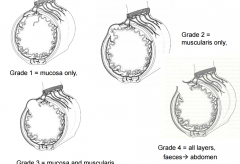
How do we grade rectal tears? |
1-4 1: Mucosa only involved. Grade 2: Muscularis only Grade 3: Mucosa and muscularis. Grade 4 : all layers and life threatening. |
|

Most important steps to take if you get a rectal tear? |
1) ID early. 2) Tell owner. 3) Institute first aid. 4) Refer. |
|
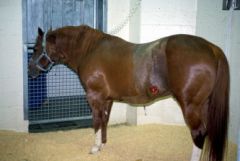
First aid for a rectal tear? |
1) Sedate. 2) Epidural or large volume of local per rectum. 3) Careful evacuation. 4) Packing rectum with lubed noted tights etc. 5) Broad spectrum A/B 6) NSAID 7) Referral for surgery if severe- colostomy to bypass the rectum or an indwelling rectal liner. |
|
|
Prognosis for rectal tears? |
1-2: good to fair.
3: guarded. 4: POOR |
|
|
Complications of colic surgery? |
1) Repeat episodes of colic. 2) Continued endotoxaemia/dehydration. 3) Ileus. 4) Incisional drainage/ infection/ herniation. 5) Adhesions. |

